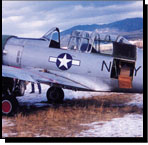



Wilkerson Plane
Madison’s
Wilkerson preparing
his rare warbird for public rides
Flying plane home was a true adventure
By
Don Ward
Editor
(June, 2002) MADISON, Ind. – Mark Wilkerson has been
buying, selling and flying airplanes for several years, but one particular
airplane – a Vultee Basic Trainer 13 – that he recently bought
from a man in Montana will go down as perhaps the most memorable.
 |
|
Mark Wilkerson's Plane |
That’s because taking delivery of the 1941 pre-war
trainer required him to fly it solo off a snow-covered mountain with
only 1,000 feet of runway and travel more than six hours to the nearest
airport for the first of three refueling stops on his way back to Madison,
Ind. What’s more, the trip took place in early December 2001, one
of the coldest months of the year.
With no heat in the aircraft, except for an electric motorcycle vest
that he had plugged into the cigarette lighter, and nothing to keep
his mind occupied for hours except for an extraordinary view of the
barren landscape of Montana and the Dakotas below him, Wilkerson prevailed.
Today, the aircraft sits in Wilkerson’s airplane hangar at the
Madison Municipal Airport, where the 42-year-old aviation mechanic and
airplane restorer is overhauling and repainting it. Wilkerson also has
five Stearman biplanes in various phases of restoration, and owns a
J-3 Cub and a Citiba aerobatic airplane.
By late June, Wilkerson hopes to have the BT-13 ready for taking people
up on $125 rides. He plans to charge $145 for two people.
“It’s really a rare aircraft and one of the first 200 made.
They were delivered to the Navy’s Moffett Field in California before
World War II,” said Wilkerson, who has been reading up on the model
from a book his wife, Kingsley, bought him for Christmas.
The BT-13 was used for training Army and Navy pilots before they advanced
to AT-6 and P-51 fighters. The planes were only used from 1940 to 1945,
then sold as surplus or scrapped for parts after the war.
“When I was stationed in Alaska in the 1950s, I saw thousands of
them stacked in a junk yard,” said Madison flight instructor Ralph
Rogers. “Many of them were taken to the Boneyard in the Phoenix
desert and the parts were sold off of them.”
Wilkerson located the aircraft through an aviation trade magazine. The
only problem was getting it home. His father, Fred Wilkerson, had no
interest in making the trip out West with him, Mark said. So he went
alone, taking a commercial flight to Billings, Mont., and then traveling
on to a magnificent mountaintop lodge where the previous owner had kept
the plane housed in a building.
Wilkerson said it was 20 below zero the morning he was preparing to
depart. It was an ordeal to just get the engine started and the plane
maneuvered into place for take off in two feet of fresh snow. He and
his father had spent two days back home charting his cross-country trip.
After jump-starting the frozen engine and filling the fuel tanks, Wilkerson
took off, just ahead of an approaching snow storm that would have grounded
him for days. Ten minutes into the flight, the battery died, so Wilkerson’s
heated vest went cold. Wilkerson could only climb as high as 10,000
feet without oxygen, so he had to maneuver the plane between 12,000-feet
mountaintops for the first four hours.
Most of the airports in the area were closed for the winter. Using a
hand-held Global Positioning Satellite instrument for guidance, he finally
landed in Glindive, Mont., for his first fuel stop and overnight stay.
The next day, he traveled six hours and reached Iowa before landing
for fuel and spending the night. The next six-hour flight got him as
far as Sullivan, Ind., on the western border. From there, it was just
over an hour flight into Madison.
Wilkerson said he averaged 150 mph for the trip, which was mostly into
head winds. When he arrived in Madison, there happened to be several
people there watching him bring it down.
“There was a lot of excitement,” Wilkerson recalled. “Everyone
wanted to see it.”
Wilkerson said his research on the aircraft says there are only about
100 of the planes still in existence out of the more than 14,500 built,
and only 35 of them are still flying. “There were more of these
planes built than any other model during the war,” he said.
The planes are valued around $150,000 and are considered among the most
affordable of the warbirds because they have no retractable landing
gear. Wilkerson’s model is powered by a 450 horsepower engine.
“It flew great coming home,” he said. “But it was really
an adventure getting here.”
• To inquire about rides, call (812) 273-1304.